#mughal history
Text

The tomb of Itimad-ud-Daula in Agra, India. Built by Nur Jahan, the wife of the Mughal Emperor Jahangir, this tomb was made for her father, and the Vazir, Mirza Ghiyas Beg in the 1620s.
It's exterior surfaces are covered in inlay work in a variety of colourful stones, while it's interior boasts exquisitely preserved wall paintings of flowers, cypress trees and and beautiful overhead painted murqarnas vaulting. The trees and flowering plants, and the swirling clouds whose designs hold their origins further east and demonstrate the sustained exchange of motifs along the Silk Roads, a defining factor of arts from both the Mughal and Timurid empires.
via Jordan Quill
#history#nur jahan#jahangir#mughals#mughal history#india#agra#south asia#south asian#indian architecture#mughal architecture#islamic architecture#indian history#ots#desi tumblr#desiblr#desi academia
275 notes
·
View notes
Text

daughters of the sun - ira mukhoty
most of the women of the mughal haraman were, in fact, not wives at all; they were mothers, like hamida banu and harkha bai, unmarried sisters, like jahanara and roshanara, divorced women, like khanzada, single daughters, like zeb-un-nisa and zeenat-un-nisa, aunts, like gulbadan, distant relatives, like salima sultan, elderly dependents, etc. they were not sexually available women at all. and yet they all had a role to play, a duty to perform, and they were respected, and paid, for these crucial jobs.
who were the mughal women behind the veil of the zenana? hidden behind the purdah, little historical accounts were recorded of the ongoings within the harem, and those that were are steeped in orientalism, western curiosity (and ethnocentricism alike) sprouting ideas of languor, lasciviousness, blouseless indian women waiting in their haveli for their shahenshah to visit them. such a lack of probing into the real story led to a disappointing overshadowing of the role played by the harem in the empire. but ira mukhoty casts this shadow away, shining the light of her in depth research and impeccable narrative to delve into the lives of some of the most influential women the world has seen.
mukhoty takes her readers through each reign of the mughal emperors, from babur's escape from samarkand to aurangzeb's mammoth of expanded territory. we hear of khanzada begum, babur's eldest sister, surrendered to shaybani khan and separated from her timurid family for almost a decade; gulbadan begum, who authored the famous humayunama, the biography of her father; nur jahan, the chief consort who had coins struck in her name, who was short of only being announced in the khutba from being the padshah herself; and jahanara begum, the daughter of shah jahan, who went from her glorious reign as padshah begum to her imprisonment in agra fort with her ailing father as her brother took the throne. interspersed are the stories of other, lesser known women of the harem -- wet nurses such as maham anaga; second, third, and fourth wives; and sisters and daughters that fall back to the sidelines. most beautifully of all, mukhoty weaves this all into a complex tapestry of female power, ambition, companionship, and spirituality, displaying in rich hues the kaleidoscope of lives suffusing the mughal harem.
after four-hundred years, the curtain of the zenana is finally pulled back -- along with the misconceptions colouring a vital chapter of female history.
#mughals#mughal empire#mughal history#history#book review#book recommendations#bookblr#historyblr#history blog#book blog#i love this painting btw#noor jahan#jahanara begum#tagged:history#tagged:mughals#tagged:bookreview#♡alizeh reads♡#tagged:daughtersofthesun#tagged:iramukhoty
9 notes
·
View notes
Text
This is only for emperors, if you are going for Someone Else they have to have been an emperor at some point. So no Dara Shukoh or any of the queens. I might make a different poll for the queens if this takes off.
Don't vote on the basis of politics - they were all objectively bad people and this is a fun poll. Vote for who you think is the most blorbo and/or who you think you can fix etc.
#mughal empire#mughals#mughal history#india#indian history#history#history polls#south asia#south asian#desiblr#desi tumblr#desi academia#polls#babur#akbar#shah jahan#auranzeb#delhi
8 notes
·
View notes
Text
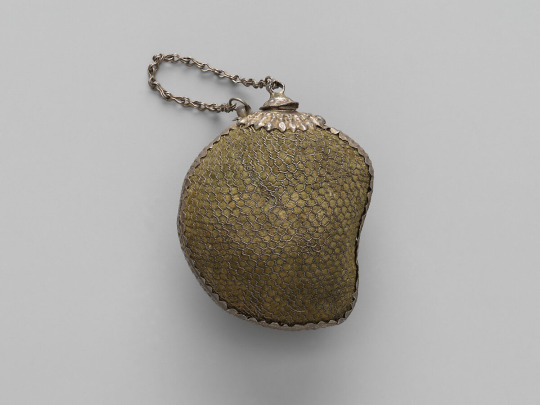
Vessel in the Form of a Mango. India (Mughal). 18th Century.
Silver and Fabric
from the Metropolitan Museum of Art
The lack of Mughal content on this blog is disturbing and criminal! Also, we've seen boar vessels and vessels of other animals, but not one of a mango?
#I love mangoes#I could use a Philippine mango right now#mughal#mughal artifacts#mughal history#history#historical artifacts
5 notes
·
View notes
Text
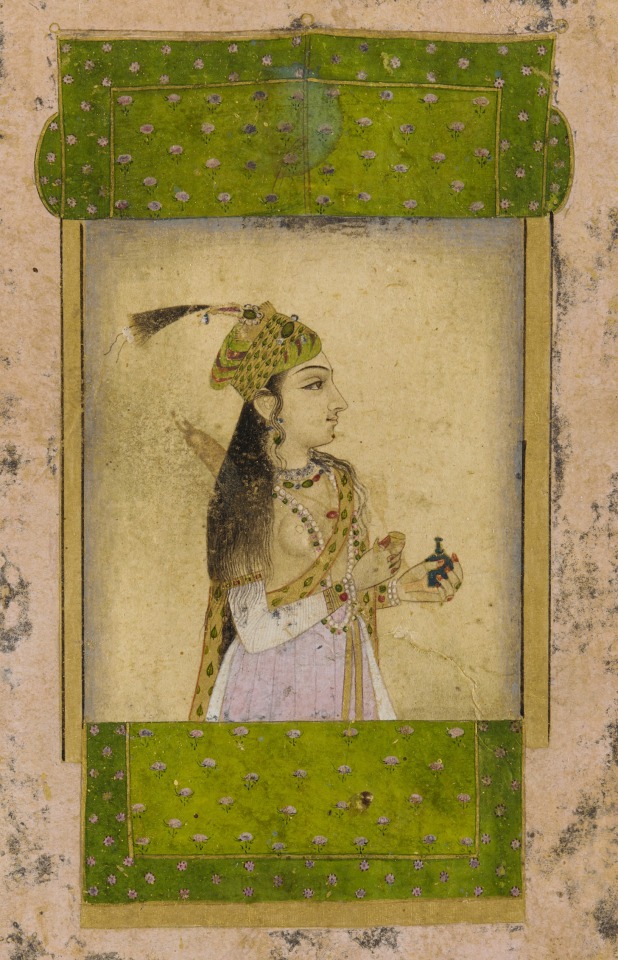
Portrait of a lady, Unknown author, 17th century
#mughal#mughal art#mughal empire#art#painting#art history#artists on tumblr#mughal history#mughal india#india#mughal painting#portrait#south asia#17th century#17th century art#1600s#1600s art#Mughal School#beautiful#woman portrait#asian art#aesthetic#tumblr#classic#classical art#classic painting#classic art
33 notes
·
View notes
Text
Biggest Lie in the History Of Love
They say Taj Mahal is the symbol of love for whole mankind. I mean how this is possible?
Mumtaz mahal was shahjahan 4th out of 8 wives.
Mumtaz died giving birth to their 14th child at the age of 38.
Later shahjahan married to Mumtaz own sister.
Shahjahan even married his own daughter Jahanara just because she looked like Mumtaz mahal.
Shahjahan had an harem of over 2000 women.
Thereby,
Taj Mahal is not the symbol of love but Lust.
#history#Lies#twisted lies#white lies#morality#hate#conflict#indian history#Mughal history#writers on tumblr#truth#spilled writing#spilled thoughts#spilled ink
3 notes
·
View notes
Text
Between all this Mughal history deletion I am starting to see the dumbasses of Tumblr rise again. The people who REALLY think Mahabharata and Ramayana are real and actual historical events need to step back from religion and read about Ancient India (especially Gupta period cuz y'all seem to have missed 6th grade)
"But it had evidence!" No ma'am 'Ram setu' is not an evidence. There something beautiful about people seeing a geographical structure they think is so beautiful, so useful, so reliable that it must have been made by Gods.
But your ass sitting in 21st century saying all that is equivalent to christian flat earthers and honestly you are no better than them. YOU ARE EXACTLY LIKE THEM 🤣
We would have easily found out about any 'atomic bomb' (Brahmastra lmao) from Mahabharata because that's how radioactivity works (heard of carbon dating fellas? It tracks things beyond human war era) 💀💀💀
#lemon's not a meme thread#hinduism#hindu mythology#indian history#mughal history#indian politics#hindutva#yall be having least amount of connection with the culture and saying all this to make youself look more indian#this way? absolutely you can't lmao#🛡️🛡️🛡️
3 notes
·
View notes
Text

Emerald ring, Mughal empire, 16th-17th century
from Christies
1K notes
·
View notes
Text
Emerald Spectacles from India, c. 1620-1660 CE: the lenses of these spectacles were cut from a single 300-carat emerald, and it was believed that they possessed mystical properties

These eyeglasses are also known by the name "Astaneh-e ferdaws," meaning "Gate of Paradise," based on the symbolic associations between the color green and the concept of spiritual salvation/Paradise. That symbolism (which is rooted in Islamic tradition) was especially popular in Mughal-era India, where the spectacles were made.
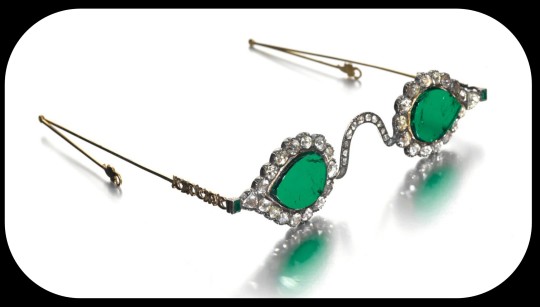
The lenses were crafted from two thin slices of the same emerald. Together, the lenses have a combined weight of about 27 carats, but given the precision, size, and shape of each lens, experts believe that the original emerald likely weighed in excess of 300 carats (more than sixty grams) before it was cleaved down in order to produce the lenses. The emerald was sourced from a mine in Muzo, Colombia, and it was then transported across the Atlantic by Spanish or Portuguese merchants.
Each lens is encircled by a series of rose-cut diamonds, which run along an ornate frame made of gold and silver. The diamond-studded frame was added in the 1890s, when the original prince-nez design was fitted with more modern frames.
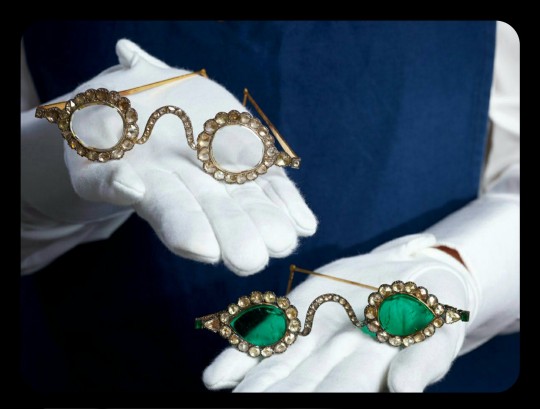
The emerald eyeglasses have long been paired with a second set of spectacles, and they were almost certainly commissioned by the same patron. This second pair is known as "Halqeh-e nur," or the "Halo of Light."
The Halo of Light features lenses that were made from slices of diamond. The diamond lenses were cleaved from a single stone, just like the emerald lenses, with the diamond itself being sourced from a mine in Southern India. It's estimated that the original, uncut diamond would have weighed about 200-300 carats, which would make it one of the largest uncut diamonds ever found.

The lenses are so clear and so smoothly cut that it sometimes looks like they're not even there.
Both sets of spectacles date back to the mid-1600s, and it's generally believed that they were commissioned by a Mughal emperor or prince. The identity of that person is still a bit of a mystery, but it has been widely speculated that the patron was Shah Jahan -- the Mughal ruler who famously commissioned the Taj Mahal after the death of his wife, Mumtaz Mahal. Shah Jahan did rule as the Mughal emperor from about 1628 to 1658.
The emerald and diamond lenses may have been chosen for symbolic, sentimental, and/or cultural reasons, or they may have been chosen simply because they're pretty and extravagant; the original meaning and purpose behind the design is still unclear. Experts do believe that the eyeglasses were designed to be worn by someone, though.
At times, it was believed that the spectacles had spiritual properties, like the ability to promote healing, to ward off evil, to impart wisdom, and to bring the wearer closer to enlightenment. Those beliefs are largely based on the spiritual significance that emeralds and diamonds can have within certain Indic and Islamic traditions -- emeralds may be viewed as an emblem of Paradise, salvation, healing, cleansing, and eternal life, while diamonds are similarly associated with enlightenment, wisdom, celestial light, and mysticism.
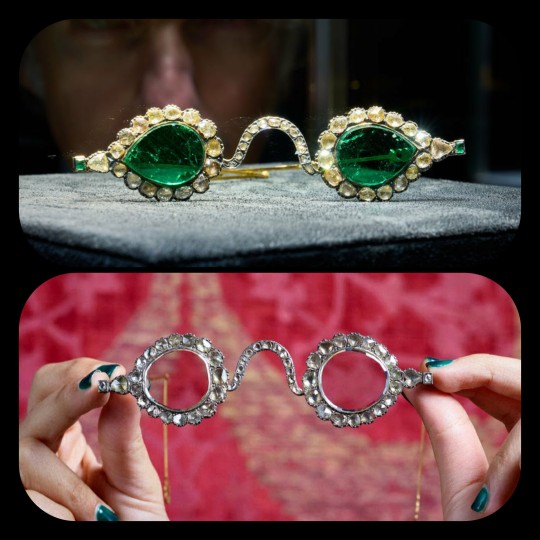
The Gate of Paradise and the Halo of Light were both kept in the collections of a wealthy Indian family until 1980, when they were sold to private collectors, and they were then put up for auction once again in 2021. They were most recently valued at about $2 million to $3.4 million per pair.
Sources & More Info:
Sotheby's: Mughal Spectacles
Architectural Digest of India: At Sotheby's auction, Mughal-era eyeglasses made of diamond and emerald create a stir
Only Natural Diamonds: Auspicious Sight & the Halqeh-e Nur Spectacles
The Royal Society Publishing: Cleaving the Halqeh-Ye Nur Diamonds
Gemological Institution of America: Two Antique Mughal Spectacles with Gemstone Lenses
Manuscript: From Satan's Crown to the Holy Grail: emeralds in myth, magic, and history
CNN: The $3.5 million Spectacles Said to Ward off Evil
BBC: Rare Mughal Era Spectacles to be Auctioned by Sotheby's
#history#archaeology#artifact#mughal#india#17th century#art#emerald#diamond#glasses#indian lore#islam#religion#mysticism#indian history#anthropology#spirituality#fashion
4K notes
·
View notes
Text


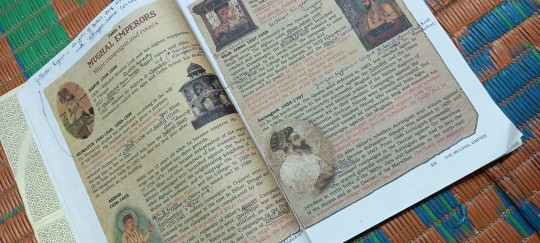
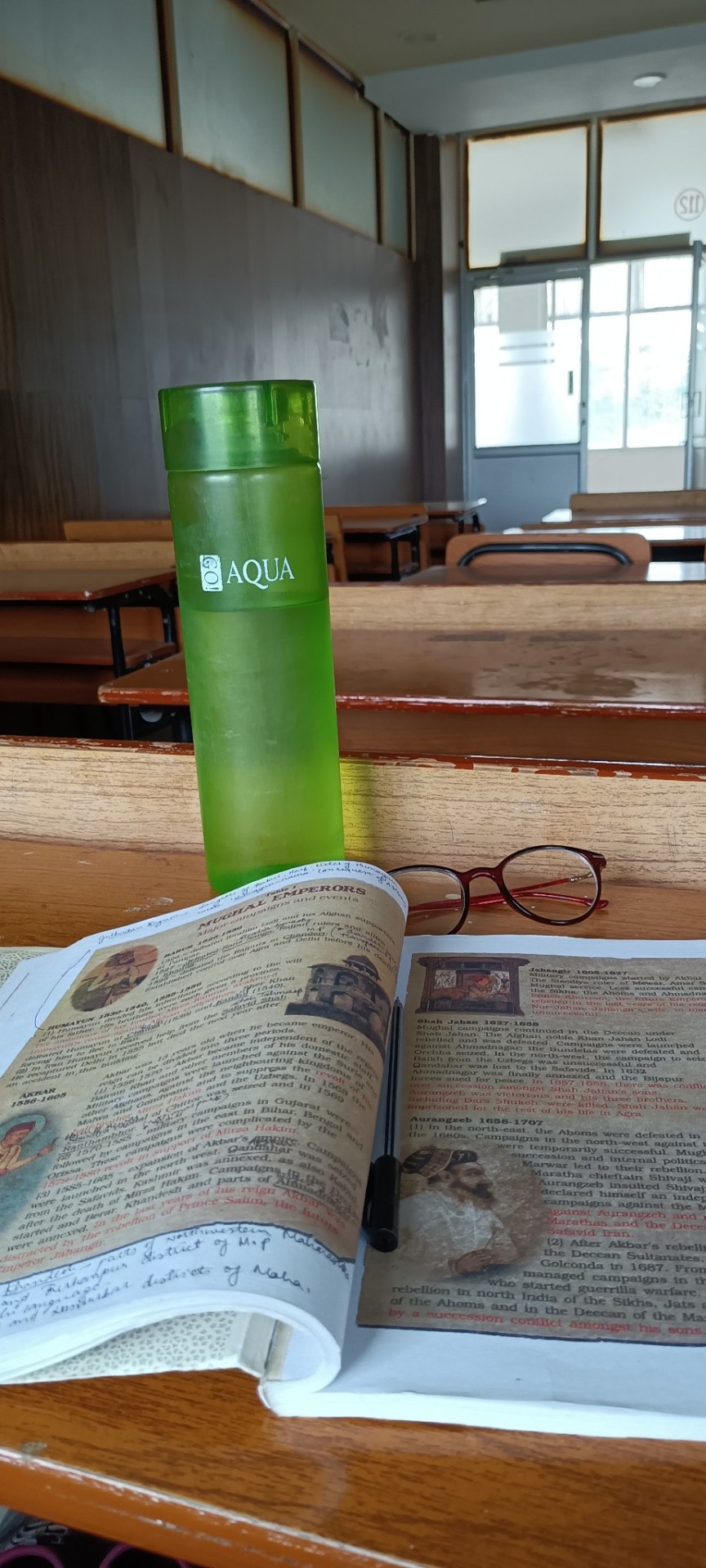
7 JULY 2022 :
Tho it was a bad day today (if not worse) I was still able to do this much. I couldn't achieve what I had in my target plan coz of unnecessary circumstances created by the staffs and teachers of my university. Even so, I will try my best to achieve them tomorrow.
I hope for a better tomorrow. *Fingers crossed* ^^
0 notes
Text
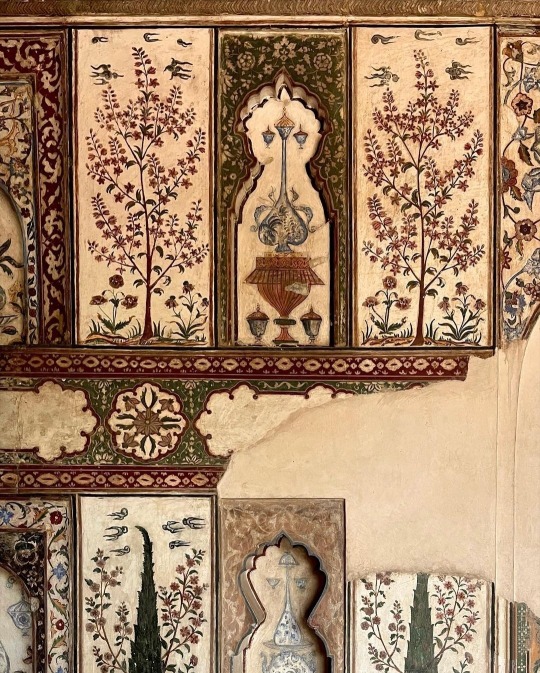
Detail of marble inlay work at the tomb of Itimad-ud-Daula in Agra, India. The tomb was built by Nur Jahan, the wife of the Mughal Emperor Jahangir, for her father, and the Vazir, Mirza Ghiyas Beg in the 1620s.
Via Jordan Quill
#ots#indian architecture#agra#india#noor jahan#mughal architecture#nur jahan#jahangir#history#indian history#marble inlay#marble inlay work#islamic architecture#desi tumblr#desiblr#mughal history
141 notes
·
View notes
Text
“glorification of an imagined unified Western Traditional Culture as the single objective best culture is a fascist red flag” and “a lot of modern vernacular architecture is boring, actively harmful to the mental health of people who live around it, destroying older buildings that had more personality, and shoddily built + as bland as possible for the ever profit-focused needs of capitalism” are concepts that can coexist
like. yes, be wary of Roman Statue Profile Pics decrying “modernity” on Twitter, but the idea that IKEAfying the world is somehow Progressive and if you don’t like it you MUST be far-right is just. bizarre
#architecture#history#also these styles destroy non-western traditional architecture too. you know that right?#a blocky glass tower doesn't look like a Japanese house or pueblo or a crenellated Ethiopian palace#if someone were to build a Mughal architecture-inspired apartment building here in Boston I'd be like 'AMAZING'#ANY architecture with personality is the opposite of Capitalist Hellscape Chic#I just often use Victorian and Georgian buildings as examples because. that's what's around me and what my background is in
1K notes
·
View notes
Text


Gilded-gold painting depicting a Mughal style Annunciation scene, showcasing Mary, future mother of Christ, with two small angels, one prostrated and the other reading from a book.
In the background, a river, fields and a well on a hill. Accents of colour in background and at figures' waists.
Mughal dynasty, India. 1600s.
British Museum. 1920,0917,0.13.21
57 notes
·
View notes
Text
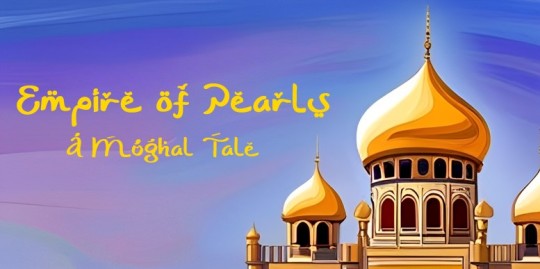
Embark on a captivating journey as you assume the identity of Birbal, a brilliant prodigy, and immerse yourself in the enigmatic realm of the Mughal Empire. Behold a world thrown into chaos following the demise of Emperor Humayun, as a mere 14-year-old Akbar inherits the illustrious throne. Your choices shall shape the destiny of this young monarch, as you aid him in becoming the legendary emperor he's destined to be, or plunge the empire into turmoil by orchestrating a web of subversion and deceit. The power to shape an empire lies within your hands.
Amidst a cast of colorful characters, tread cautiously as you determine which souls can be deemed trustworthy, while remaining ever vigilant for those who may, with a swift and treacherous strike, plunge a dagger deep into your unsuspecting back. In this enthralling tale of loyalty and betrayal, the art of discerning friend from foe becomes your most vital survival skill. Make allies, face challenges and uncover hidden secrets. Just as internal conflict reaches a boiling point, the walls of the royal palace begin to tremble, beckoning you take a stance. Whose side will you embrace?
Empire of Pearls: A Mughal Tale is an interactive story inspired by historical events. It is set at the beginning of Abu'l-Fath Jalal-ud-din Muhammad Akbar's reign as the youngest-ever Mughal Emperor where you play as his most trusted advisor and friend, Birbal. This reimagined work is entirely text-based and your choices help shape Birbal's personality, skills, relationship with others, and of course the fate of the Empire.
Content warning: This game explores dark themes such as abuse, bullying, manipulation, use of drugs and alcohol, blood, gore, violence etc. and is strictly rated 18+. Besides that more in depth warnings will be provided before each chapter and certain trigger points can be turned off completely at the start of the game.
Demo | Character Appearances | Tags | FAQ |

Play as male or female and choose your real name and sexuality.
Customize your appearance and personality.
Choose one of three different backgrounds that will impact your reputation and relationships:
A noble possessing a remarkable talent, invited to join the court by Emperor Humayun himself; a child of a maid serving a powerful military commander, hired on the recommendation of the commander or a street urchin caught stealing from the royal palace, rewarded with a place in the elite circle owing to the incredible feat.
Romance any of the five different love interests or not. Friendship is always an option.
Be a part of an elite group of courtiers serving none other than Emperor Akbar and shape the fate of the Empire.

Abu'l-Fath Jalal-ud-din Muhammad Akbar (he/him) 💕 : The newly crowned young emperor. Friendly and affable, the ruler has a tendency to be a bit impulsive at times. Despite his age he has been preparing for this role for years and doesn't seem at all nervous to be the new monarch. Akbar can be a powerful friend and an equally dangerous foe. How he perceives you vary depending on your background. A year younger than Birbal.
...........
Bairam Khan (he/him): A military commander and the most trusted ally of the throne until the death of Emperor Humayun. Since then he has been promoted to commander-in-chief, if that wasn't all he also happens to be Akbar's guardian, chief mentor and advisor. Bairam knows his way around the empire but can you actually trust this man?
...........
Ruqaiya Sultan Begum (she/her) 💕: An aloof but fiercely loyal woman and Akbar's first wife. Being cousins, neither of them ever saw each other as anything but friends. But Ruqaiya also hides a big secret, one that has her loathing herself. Will you able to form a deep enough connection to assist her in embracing her true self and breaking free from her constraints? A year younger than Birbal.
...........
Salima Sultan Begum (she/her): A strong and intelligible woman and Akbar's second wife. She feels heavily undervalued and undermined by the court which causes her to constantly act out and push the boundaries of what is acceptable for a woman. Though she sees Akbar as a friend, anything more than that with anyone is unfathomable to her. Two years younger than Birbal.
...........
Mahira Khan Mughal (she/her) 💕: A softspoken and timid young woman sold as a political pawn by her own father to become Akbar's third wife. Mahira longs for companionship and understanding which she can't find in the palace but you can fill that void in her life by secretly courting her or by providing the friendship she desperately craves. Two years younger than Birbal.
...........
Arslan Khan (he/him)💕: The son of Bairam Khan and another young prodigy, seemingly possessing supernatural powers and later becoming known as the legendary Mulla Do-Pyaza. With a mixture of rivalry and occasional bullying, he views Birbal as a formidable adversary. Arslan, driven by an insatiable desire for his father's approval, harbors a volatile temper that ignites at the mere mention of insults hurled towards his family. Peering beyond the myth, can you uncover the man within? A year older than Birbal.
...........
Nadeem/Nadia Mirza (opposite gender of Birbal) 💕: Birbal's betrothed and distant cousin of Akbar. A noble with a secret lover, N only accepted the marriage offer because it was arranged by commander-in-chief Bairam Khan himself and it was made obvious that refusal would not bear good consequences for their family. Can you form a connection with your betrothed despite the rocky start? Two years older than Birbal.
#interactive fiction#if wip#romance#history#drama#LGBTQIA#choicescript#no demo#intro post#dashingdon#empire of pearls#empire of pearls: a mughal tale#mughal era#historical#interactive#choice of games#hosted games#tragedy
351 notes
·
View notes
Text

Emerald with the seal of Emperor Jahangir, Mughal Empire (India), 1018 AH (1609-1610 AD)
from The Museum of Islamic Art, Qatar
1K notes
·
View notes
Text

Brighton & Hove News, 28 July 2023:
'A Brighton family have literally stopped traffic with a new mural inspired by a sari pattern on their new home.
Poppy Jaman and Jaan Madan moved to Southampton Street in Hanover in January, and immediately knew they wanted to make a splash when decorating the outside.
She said: “One of the reasons we wanted to move to the centre of Brighton is that it���s so colourful.
“We were inspired by murals in Washington where there’s a whole area where there’s murals which have been created out of adversity.
“That inspired the idea of making a statement with our home. I wanted to not just paint something that I love. If you just love something that’s enough, but I also wanted to say here’s a bit of my identity.
“I collect saris and Jamdani is a signature saris of Bangladesh. It’s got a colonial past to it.

📷 X
The mural is inspired by the Jamdani weave saree, the signature saree of Dhaka, Bangladesh, which dates back at least as far back as 300BC.
Between the 16th and 19th centuries, Jamdani fabric – so fine it was known as ‘woven air’ – was one of the most highly coveted commodities in Mughal courts and further afield. However, by the mid-19th century, Jamdani had become almost extinct.
Poppy has written more about her relationship with the Jamdani design and its colonial history here.'
#sari#mural#brighton#mughal#textiles#textile history#jamdani#dhaka#bangladesh#colonial history#indian history#weave#woven fabric#pattern#surface pattern#surface pattern design#pattern design#textile design#surface decoration#street art#uk#england#british asian#saree#traditional crafts#traditional textiles#traditional clothing#bengali#weaving
126 notes
·
View notes